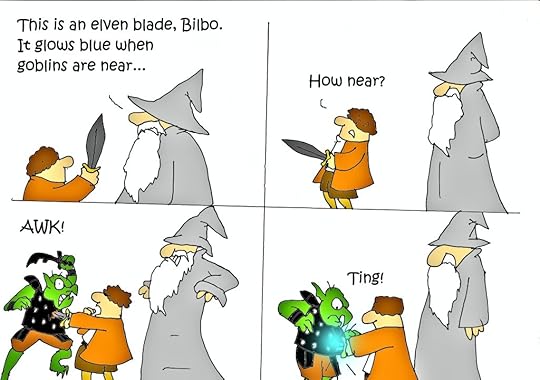Adrian Tchaikovsky's Blog, page 7
February 4, 2016
Spiderlight cover reveal
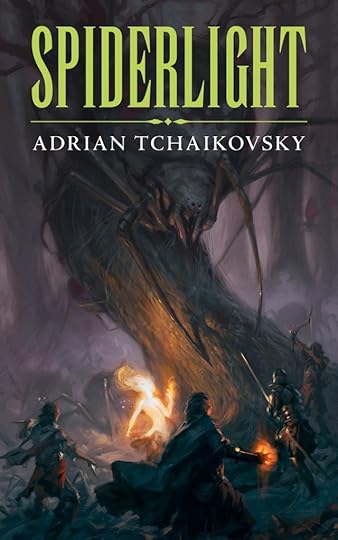 In August, Tor.com will be publishing my novel Spiderlight, which will be my first US-side release for… a long time, actually. It will also be available in the UK, and possible elsewhere. Possibly I’ll do a signing tour of Mirkwood.
In August, Tor.com will be publishing my novel Spiderlight, which will be my first US-side release for… a long time, actually. It will also be available in the UK, and possible elsewhere. Possibly I’ll do a signing tour of Mirkwood.
The cover for the book has just been revealed and I give you it here. This is not only a fantastic fantasy cover, but if you feel it looks a little like the cover of a fantasy RPG book, the artist is Tyler Jacobson who you might best know as responsible for the cover of the D&D 5th edition Players’ Handbook. That’s right, I have a book cover by a D&D artist. I cannot stress how very, very happy this makes me. I never thought it was a thing that could happen, but if I’d thought of it, it would have been a writing victory condition. Also, I have endless respect for an artist who does a good spider without anthropomorphising it at all. 
February 2, 2016
Bard to the bone
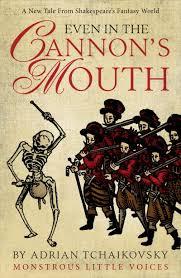 Who’s up for a bit of culture?
Who’s up for a bit of culture?
Specifically Shakespeare!
(waits)
Anyone left? Or was everyone poisoned by tedious literature classes? My confession: I love Shakespeare. I used to act(1) in an amateur dramatics company back in Reading and we did a Shakespeare every year in the Abbey Ruins, which was a pretty good venue for it, and before that (and overlapping) there was a university group as well. And, as the writing took off, I often harboured thoughts about doing a little spear-shaking of my own. After all, Tad Williams did it with Caliban’s Hour, so who knows.
So, Shakespeare is a lot like buses. You wait for years and then two come along one after the other. Which is exactly the sort of joke I can’t make work, but Shakespeare would have added a pratfall and a veiled reference to genitalia and had the groundlings rolling in the… on the ground.
First of all, Mr David Moore, impressario of Abaddon Press, tapped me to write a novella for his new production of Monstrous Little Voices, a linked collection of stories set “in the world of Shakespeare. These are Coral Bones, by Foz Meadows, The Course of True Love by Kate Heartfield, The Unkindest Cut by Emma Newman, my own Even in the Cannon’s Mouth, and finally On The Twelfth Night by Jonathan Barnes. The backdrop is a grand European war between various Shakespearean principalities, and my own story concerns a band of characters from the comedies on an embassy from Aragon to Milan who get wrecked on the shore of hostile Ilyrria to come face to face with the new magical weapon that Duke Orsino has recruited. I have pirated at least five plays for my cast, and I had colossal fun writing it. Even in the Cannon’s Mouth can be read on its own, or in sequence with the others, which I can heartily recommend. It’s now available for pre-order here or the entire collection is here.
 Secondly, the first kickstarter I ever contributed to has just successfully funded, being Jonathan Green’s Shakespeare vs Cthulhu, a fairly self-explanatory collection of stories. My contribution is Something Rotten in which Horatio finally reveals the real dark secret of the Danish royal family…
Secondly, the first kickstarter I ever contributed to has just successfully funded, being Jonathan Green’s Shakespeare vs Cthulhu, a fairly self-explanatory collection of stories. My contribution is Something Rotten in which Horatio finally reveals the real dark secret of the Danish royal family…
.
.
Finally, a little cartoon for February for your delectation, which is nothing to do with Shakespeare.
January 14, 2016
Tiger Wolf Launcharama
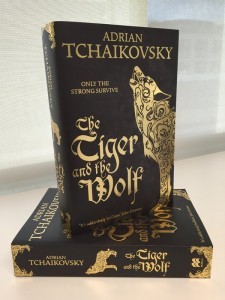 The Tiger and the Wolf comes out in about three weeks, and I shall be part of an Authorial Omnithon at London's Forbidden Planet on the 12th of February BUT THAT IS NOT ALL! As well as the chance to pick up a signed copy of the start of my new series, containing words nobody has ever seen before (1), but you should also come along for my esteemed colleagues Den Patrick, Mark Turner and the very talented Peter Newman. We shall be there, and we shall line up and look like the worst boy band ever. This is Fantastic Fantasy (2) and it will occur only when the clocks strike six and cease promptly when they strike seven, after which we will turn into pumpkins and go and get drunk somewhere.
The Tiger and the Wolf comes out in about three weeks, and I shall be part of an Authorial Omnithon at London's Forbidden Planet on the 12th of February BUT THAT IS NOT ALL! As well as the chance to pick up a signed copy of the start of my new series, containing words nobody has ever seen before (1), but you should also come along for my esteemed colleagues Den Patrick, Mark Turner and the very talented Peter Newman. We shall be there, and we shall line up and look like the worst boy band ever. This is Fantastic Fantasy (2) and it will occur only when the clocks strike six and cease promptly when they strike seven, after which we will turn into pumpkins and go and get drunk somewhere.
Also in London, I am the guest of Jen Williams and Den Patrick at the Super Relaxed Fantasy Club on Tuesday 23rd February where I will be doing a reading, answering questions and then my usual thing of just lurking about awkwardly. Details can be had in due course from their Facebook page here. I would also note that Jen Williams will be signing copies of her own The Silver Tide, the third in the Copper Promise series at 6pm on 25th February that week.
(1) Small print: all words may have been seen before individually but hopefully not in this order
(2) They should have just called it "Fantastical Fantastical" like the show title from Moulin Rouge.
January 11, 2016
A Very Inhuman New Year To You All!
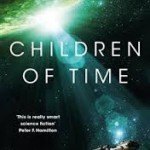 So I feel I've been putting in the hours on my inhuman characters, what with the protagonists of Children of Time and this year's release of Spiderlight from Tor UK, as well as more human examples like the insect-kinden, or the shapeshifters of The Tiger and the Wolf. I first got into SF for the aliens. When I was a kid I would inch through the frames of the Cantina scene in Star Wars to admire all the critters (many of which were basically halloween masks, of course). I loved the alien bounty hunters in Empire and Cayman of the Lambda Zone in Battle Beyond the Stars (1). As can be seen from my obsession with bugs and the like, I have always identified with the outsider. When I became a writer, a kind of holy grail occurred to me: the ultimate outsider as protagonist — a point of view that was genuinely detached from the human, and yet which human readers (2) would relate to. I'm not sure it's possible — those are two opposing magnet poles we're talking about. I would flatter myself that I've come close with Children of Time. Certainly the reaction people have had to Portia and her kin was what I hoped for — the characters coming over as both sympathetic and inhuman at once. However they are bad examples. They are creatures of our earth, further humanised by simian meddling. The holy grail continues to elude.
So I feel I've been putting in the hours on my inhuman characters, what with the protagonists of Children of Time and this year's release of Spiderlight from Tor UK, as well as more human examples like the insect-kinden, or the shapeshifters of The Tiger and the Wolf. I first got into SF for the aliens. When I was a kid I would inch through the frames of the Cantina scene in Star Wars to admire all the critters (many of which were basically halloween masks, of course). I loved the alien bounty hunters in Empire and Cayman of the Lambda Zone in Battle Beyond the Stars (1). As can be seen from my obsession with bugs and the like, I have always identified with the outsider. When I became a writer, a kind of holy grail occurred to me: the ultimate outsider as protagonist — a point of view that was genuinely detached from the human, and yet which human readers (2) would relate to. I'm not sure it's possible — those are two opposing magnet poles we're talking about. I would flatter myself that I've come close with Children of Time. Certainly the reaction people have had to Portia and her kin was what I hoped for — the characters coming over as both sympathetic and inhuman at once. However they are bad examples. They are creatures of our earth, further humanised by simian meddling. The holy grail continues to elude.
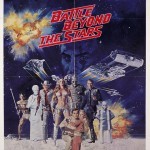 Why bother trying to write from the point of view of something your audience may have a tough time relating to? Because it teaches us about ourselves (which is a good answer to pretty much any 'Why fantasy?' or 'Why SF?' kind of question. But also because exploring the other is a valid goal in itself. Especially now. We are perilously close to meeting the Other in real life — in a form we ourselves create. Serious non-SF people are debating what laws should bind artificial intelligences even now, and what rights they will have. I've been on and watched relevant panels at most conventions this year and the topic has shifted from "writing non-human characters" to "non-humans in real life". (At Fantasycon, I think it was, I had a serious moment of laconic nihilism. Someone asked "How do you think people will handle granting rights to AIs?" they asked. "Badly," was my reply. But on that subject, I'd argue that all that SF from RUR up has been based very solidly on human nature.
Why bother trying to write from the point of view of something your audience may have a tough time relating to? Because it teaches us about ourselves (which is a good answer to pretty much any 'Why fantasy?' or 'Why SF?' kind of question. But also because exploring the other is a valid goal in itself. Especially now. We are perilously close to meeting the Other in real life — in a form we ourselves create. Serious non-SF people are debating what laws should bind artificial intelligences even now, and what rights they will have. I've been on and watched relevant panels at most conventions this year and the topic has shifted from "writing non-human characters" to "non-humans in real life". (At Fantasycon, I think it was, I had a serious moment of laconic nihilism. Someone asked "How do you think people will handle granting rights to AIs?" they asked. "Badly," was my reply. But on that subject, I'd argue that all that SF from RUR up has been based very solidly on human nature.
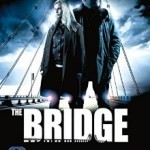 Before engaging the hyperdrive and shooting off into SF, let's talk about The Bridge. This is a Danish-Swedish police show which is exceptionally good, whilst also being rather grim and dour. One of the reasons it is so intensely engaging is the character of Saga Noren (portrayed by Sofia Helin). Saga is one of Sweden's top detectives. She is also on the autistic spectrum: she has great difficulty with social niceties, appropriate conversation and relationships with others, whilst having an incredible eye for detail backed by incomparable drive and determination. But Saga is not the "splinter skill" idiot savant we often see in those situations. She is s a complex character, at once an outsider and the absolute backbone of the Malmo PD. While she presents Saga as relatively affectless, Helin still puts over the character's deep emotional life. (3)
Before engaging the hyperdrive and shooting off into SF, let's talk about The Bridge. This is a Danish-Swedish police show which is exceptionally good, whilst also being rather grim and dour. One of the reasons it is so intensely engaging is the character of Saga Noren (portrayed by Sofia Helin). Saga is one of Sweden's top detectives. She is also on the autistic spectrum: she has great difficulty with social niceties, appropriate conversation and relationships with others, whilst having an incredible eye for detail backed by incomparable drive and determination. But Saga is not the "splinter skill" idiot savant we often see in those situations. She is s a complex character, at once an outsider and the absolute backbone of the Malmo PD. While she presents Saga as relatively affectless, Helin still puts over the character's deep emotional life. (3)
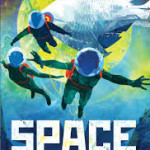 What struck me while watching the second series was that you could have set the show in the near future and made Saga an android, and a lot of the script would have worked as is (she is even called a "robot" in an argument with a colleague). Whether Saga's internalised emotional life would survive, though, is another matter. We often see artificial or inhuman life portrayed as being our intellectually equals (or superiors) in reasoning, but unable to cope with the intricacies of human emotions (Spock, anyone? Or any of those aliens who suddenly become sympathetic when they discover This Human Thing You Call Love). And this, of course, despite the likelihood that many of our emotions (biochemical reactions as they are) evolved before conscious rational thought. We see our rationality as an ideal and universal state that artificial and alien minds must inevitably converge on, while our emotional life is ours and ours alone, the thing that allows us to relate to each other and makes us human. And it is approaching that emotional life from their initial position of cold logic that redeems the alien or the mechanical, and grants them the Big Gold Star that is Being a Second Class Human.
What struck me while watching the second series was that you could have set the show in the near future and made Saga an android, and a lot of the script would have worked as is (she is even called a "robot" in an argument with a colleague). Whether Saga's internalised emotional life would survive, though, is another matter. We often see artificial or inhuman life portrayed as being our intellectually equals (or superiors) in reasoning, but unable to cope with the intricacies of human emotions (Spock, anyone? Or any of those aliens who suddenly become sympathetic when they discover This Human Thing You Call Love). And this, of course, despite the likelihood that many of our emotions (biochemical reactions as they are) evolved before conscious rational thought. We see our rationality as an ideal and universal state that artificial and alien minds must inevitably converge on, while our emotional life is ours and ours alone, the thing that allows us to relate to each other and makes us human. And it is approaching that emotional life from their initial position of cold logic that redeems the alien or the mechanical, and grants them the Big Gold Star that is Being a Second Class Human.
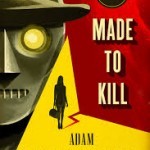 Going through the literature, though, there have been some recent books that are all about the inner emotional life of the inhuman, and which take emotion as a key building block, rather than the final icing on the cake of awareness. I recently finished Adam Christopher's Made To Kill, which is a superb noir detective story set in an alternative 60s where a wave of robot labour has come and then, after protests, gone, leaving a single robot detective stranded above the tide mark. The first person narrator of Made To Kill is a curious individual to get to know. He is as mentally and emotionally robust as he physically, but he is limited by his memory. Every day he needs to return to the office where his officiating computer Ada, another fascinating AI character, needs to put in a new tape. Hence, like Latro from Wolfe's Soldier in the Mists, he knows only what he is told about his past. And he repeatedly realises that Ada is not necessarily telling him everything, just as he isn't telling us everything. The result is a narrative constantly bounded by the artificial limitations of its narrator, who has a serious disability and has philosophically learned to live with it.
Going through the literature, though, there have been some recent books that are all about the inner emotional life of the inhuman, and which take emotion as a key building block, rather than the final icing on the cake of awareness. I recently finished Adam Christopher's Made To Kill, which is a superb noir detective story set in an alternative 60s where a wave of robot labour has come and then, after protests, gone, leaving a single robot detective stranded above the tide mark. The first person narrator of Made To Kill is a curious individual to get to know. He is as mentally and emotionally robust as he physically, but he is limited by his memory. Every day he needs to return to the office where his officiating computer Ada, another fascinating AI character, needs to put in a new tape. Hence, like Latro from Wolfe's Soldier in the Mists, he knows only what he is told about his past. And he repeatedly realises that Ada is not necessarily telling him everything, just as he isn't telling us everything. The result is a narrative constantly bounded by the artificial limitations of its narrator, who has a serious disability and has philosophically learned to live with it.
The subject is also touched on in Sophia MacDougall's Space Hostages (which I've praised before). One of the most alien things about the major alien race introduced therein is its attitute towards its own emotional life — which parts it overtly celebrates, which parts are culturally hidden away — a very different treatment to the typical malevolent alien invader trope.
 Gareth Powell is a writer who has shared the non-human character panels with me often enough that we practically have a double act going. His credentials come from the Ack-Ack Macaque books, which include both the titular uplifted monkey and another character who survives only as a kind of semi-AI recording of a human mind. Both characters are used to explore the key What-Am-I? question. In Hive Monkey, Ack-Ack spends the book wrestling with the problem of being singular — a fully aware freak of science like nothing else in his world. Meanwhile the AI construct Paul is aware that he was never designed to last forever. As with Christopher's Ray, there is a curious pathos to being inhuman in a human world, whether it comes from within (and despite his belligerent nature, Powell's monkey has some deeply melancholy thoughts on the subject (4)) or from without. I'm going to throw Gene Wolfe in as well, because his writing has a large number of artificial characters who are presented as fully sentient, and often morally superior to their human counterparts. At the risk of spoilers, Jonas and Doctor Talos in Book of the New Sun, the Chems in the Long Sun books and even the artificial soldiers of the short story 'The HORARS of War' are very sympathetic inhuman characters, and all used to turn a glass on what it is to be human.
Gareth Powell is a writer who has shared the non-human character panels with me often enough that we practically have a double act going. His credentials come from the Ack-Ack Macaque books, which include both the titular uplifted monkey and another character who survives only as a kind of semi-AI recording of a human mind. Both characters are used to explore the key What-Am-I? question. In Hive Monkey, Ack-Ack spends the book wrestling with the problem of being singular — a fully aware freak of science like nothing else in his world. Meanwhile the AI construct Paul is aware that he was never designed to last forever. As with Christopher's Ray, there is a curious pathos to being inhuman in a human world, whether it comes from within (and despite his belligerent nature, Powell's monkey has some deeply melancholy thoughts on the subject (4)) or from without. I'm going to throw Gene Wolfe in as well, because his writing has a large number of artificial characters who are presented as fully sentient, and often morally superior to their human counterparts. At the risk of spoilers, Jonas and Doctor Talos in Book of the New Sun, the Chems in the Long Sun books and even the artificial soldiers of the short story 'The HORARS of War' are very sympathetic inhuman characters, and all used to turn a glass on what it is to be human.
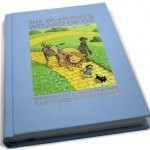 And what about L. Frank Baum? I don't think he intended The Wizard of Oz as a key transhumanist text, but having perused it recently, it's absolutely a valid reading. The Scarecrow is a spontaneous artificial mind, and the Tin Man is basically a benevolent Cyberman decades before they lumbered their way into Doctor Who. They start off very much defined by their unliving natures — and generally in a positive way because it allows them to overcome obstacles their living comrades cannot. However they also start internally limited by their awareness of their nature. The Scarecrow comes up with most of the ideas, yet feels the lack of a brain; the Tin Man cares deeply, yet believes the lack of a heart lessens him. The wizard solves their problems by chicanery, but that's fine because — and yes, it is a trite saying, but here it's relevant — the qualities were always inside them. They were held back only by their own belief in their second class nature. (5)
And what about L. Frank Baum? I don't think he intended The Wizard of Oz as a key transhumanist text, but having perused it recently, it's absolutely a valid reading. The Scarecrow is a spontaneous artificial mind, and the Tin Man is basically a benevolent Cyberman decades before they lumbered their way into Doctor Who. They start off very much defined by their unliving natures — and generally in a positive way because it allows them to overcome obstacles their living comrades cannot. However they also start internally limited by their awareness of their nature. The Scarecrow comes up with most of the ideas, yet feels the lack of a brain; the Tin Man cares deeply, yet believes the lack of a heart lessens him. The wizard solves their problems by chicanery, but that's fine because — and yes, it is a trite saying, but here it's relevant — the qualities were always inside them. They were held back only by their own belief in their second class nature. (5)
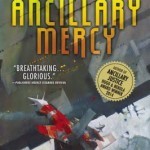 And then we have the Imperial Radch series from Ann Leckie, which starts with the omni-award-winning Ancillary Justice and goes from strength to strength. I've written about Justice before, and the second book, Sword, is good, and Ancillary Mercy is exceptional. The entire series concerns the life of an AI, shoehorned into a single human body having previously been a huge warship and the hundreds of slaved soldiers that served aboard it. The protagonist of the series is a mind at once very alien and very human. She is used to splitting her attention between multiple locations and it's one of Leckie's gifts that this comes out clear as crystal and complements the internal life of the narrator at every turn. Far from being calculating war machines, the ships of the Imperial Radch are fiercely emotionally attached to their captains and crew, and indeed the great-heartedness of the Justice of Toren is a quality that seems inhuman not in its artificiality but in its intensity. The ship is able not just to think about all those under its protection, but to care deeply in a way that makes many of the hum characters seem shallow, self-involved and greedy. And of course it does, because how can they match the depth and breadth of experience and understanding that a ship can have? And from there, of course, we're heading on a course that might eventually bring us round to the godlike Minds of Iain M Banks' Culture novels and an entire different level of the inhuman…
And then we have the Imperial Radch series from Ann Leckie, which starts with the omni-award-winning Ancillary Justice and goes from strength to strength. I've written about Justice before, and the second book, Sword, is good, and Ancillary Mercy is exceptional. The entire series concerns the life of an AI, shoehorned into a single human body having previously been a huge warship and the hundreds of slaved soldiers that served aboard it. The protagonist of the series is a mind at once very alien and very human. She is used to splitting her attention between multiple locations and it's one of Leckie's gifts that this comes out clear as crystal and complements the internal life of the narrator at every turn. Far from being calculating war machines, the ships of the Imperial Radch are fiercely emotionally attached to their captains and crew, and indeed the great-heartedness of the Justice of Toren is a quality that seems inhuman not in its artificiality but in its intensity. The ship is able not just to think about all those under its protection, but to care deeply in a way that makes many of the hum characters seem shallow, self-involved and greedy. And of course it does, because how can they match the depth and breadth of experience and understanding that a ship can have? And from there, of course, we're heading on a course that might eventually bring us round to the godlike Minds of Iain M Banks' Culture novels and an entire different level of the inhuman…
(1) Anyone else remember that? Magnificent Seven in space, Roger Corman directing, cast included Robert Vaughn and George Peppard, as well as wossname from the Waltons. A surprisingly satisfying post SW SF film. One of Corman's last and, imho, best films.
(2) Curse my too, too human readership! 
(3) I can't stress enough how good this series is. It is Grim As Hell, so you need to be up for a lot of unhappy endings, but my God it is a powerful piece of drama.
(4) Which he exorcises by punching and shooting people.
(5) As a bonus, the book I re-read was the beautiful new edition illustrated by Evan Dahm, which you can find here. Dahm is the artist behind the webcomics Rice Boy, Order of Tales and the currently ongoing Vattu, and a supremely gifted creator of fantastic worlds.
January 10, 2016
January Cartoon and more bad art
So it's January, and though I'm working up a post about non-human characters, it isn't ready yet, so here's some art.
Firstly, a cartoon to kick the year off. A bit of Harry Potter in fact.
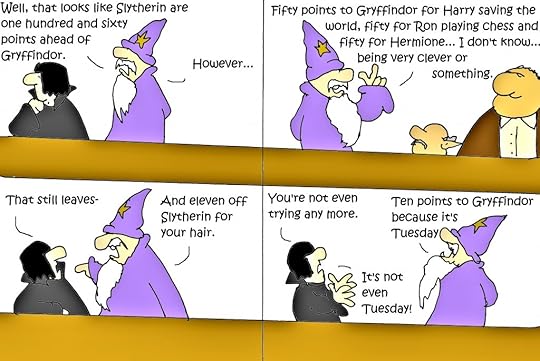 I have gone one further than that, and recently acquired a drawing tablet, because drawing by hand and then scanning in is quite a faff. I've tried it out for "serious" drawing rather than cartooning, so far (1) and the first attempt is below. It's pretty ropey, and that guy is very clearly about to get his head bashed in any moment.
I have gone one further than that, and recently acquired a drawing tablet, because drawing by hand and then scanning in is quite a faff. I've tried it out for "serious" drawing rather than cartooning, so far (1) and the first attempt is below. It's pretty ropey, and that guy is very clearly about to get his head bashed in any moment.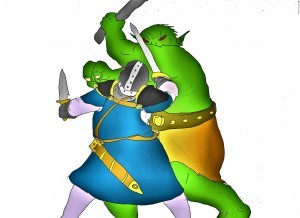
(1) Still not very serious.
January 3, 2016
Empire in Black and Gold
All is in turmoil as the world moves towards war. In Solarno, the spies watch each other and ready their knives, while Myna sees the troops muster at its border and emotions run high as it vows never to be enslaved again. In Collegium, the students argue politics, too late to turn the tide.
In the heart of the Empire, new pilots have completed their secretive training, generals are being recalled to service and armies are ready to march. Their Empress, the heir to two worlds, intends to claim her birthright. And nothing — either within the Empire or beyond it — will stand in her way.
A conflict is coming, the like of which the insect-kinden have never seen.
Reminiscent of much that's gone before from the likes of Gemmel, Erikson, Sanderson and Cook but with its own unique and clever touch …Terrific
Sci-Fi-London.com
I cannot even begin to explain how much I enjoy the Shadows of the Apt books … some of the best fantasy entertainment out there
LECBookReviews blog
He has a unique voice … an epic and complex story
WalkerofWorlds.com
January 2, 2016
Books
Novels
Click on a cover for the Amazon link.
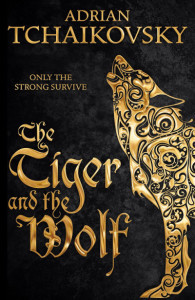
The Tiger and the Wolf : Echoes of the Fall book 1
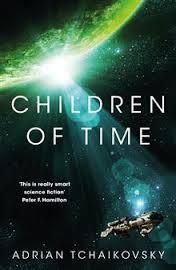
Children of Time

Guns of the Dawn
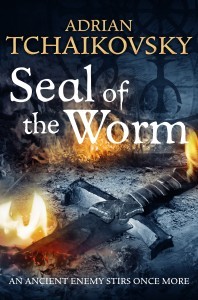
Seal of the Worm : Shadows of the Apt book 10

War Master’s Gate : Shadows of the Apt book 9
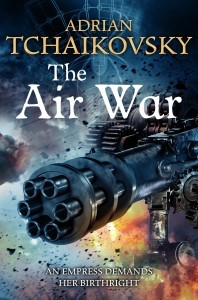
The Air War: Shadows of the Apt book 8
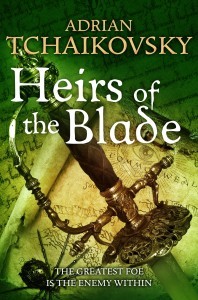
Heirs of the Blade: Shadows of the Apt book 7
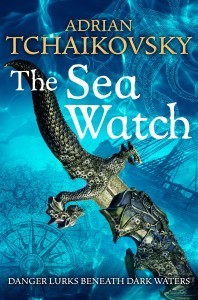
The Sea Watch: Shadows of the Apt book 6
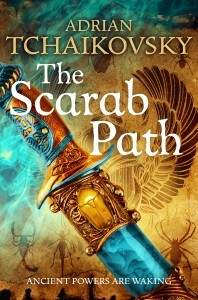
The Scarab Path: Shadows of the Apt book 5
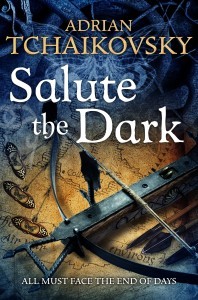
Salute the Dark: Shadows of the Apt book 4
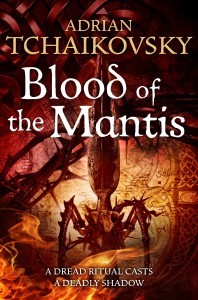
Blood of the Mantis: Shadows of the Apt book 3
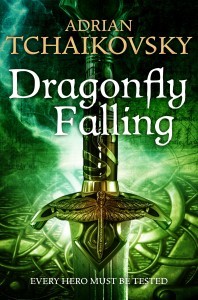
Dragonfly Falling: Shadows of the Apt book 2

Empire in Black and Gold: Shadows of the Apt book 1
The Air War
 AN EMPRESS DEMANDS HER BIRTHRIGHT
AN EMPRESS DEMANDS HER BIRTHRIGHT
All is in turmoil as the world moves towards war. In Solarno, the spies watch each other and ready their knives, while Myna sees the troops muster at its border and emotions run high as it vows never to be enslaved again. In Collegium, the students argue politics, too late to turn the tide.
In the heart of the Empire, new pilots have completed their secretive training, generals are being recalled to service and armies are ready to march. Their Empress, the heir to two worlds, intends to claim her birthright. And nothing — either within the Empire or beyond it — will stand in her way.
A conflict is coming, the like of which the insect-kinden have never seen.
Reminiscent of much that's gone before from the likes of Gemmel, Erikson, Sanderson and Cook but with its own unique and clever touch …Terrific
Sci-Fi-London.com
I cannot even begin to explain how much I enjoy the Shadows of the Apt books … some of the best fantasy entertainment out there
LECBookReviews blog
He has a unique voice … an epic and complex story
WalkerofWorlds.com
December 22, 2015
And so this is Christmas, and what have you done…?
 About to sign off for the festivities, and I wish everyone a splendid holiday in good company. There are a few things I particularly want to note my thankfulness for.
About to sign off for the festivities, and I wish everyone a splendid holiday in good company. There are a few things I particularly want to note my thankfulness for.
Thank you to pretty much everyone I'm in contact with on social media for not in any way spoiling The Force Awakens. I am similarly not going to spoil it, but I enjoyed it, I thought it was a worthy sequel. There are criticisms that are valid (and by now all over the internet), but for me they don't outweigh the overall quality and experience of the thing. As someone for whom Star Wars was The Thing when I was growing up, this was a sequel that made me very happy. If you are up for spoilers I can endorse the opinions expressed by Mr Cornell here.
This is the season of best-ofs, and I did my own round up here. I am extremely gratified to discover one or other of my books have turned up on a few elsewhere, which isn't
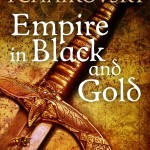 something that's happened much before (any other considerations aside, it is hard to plug, say, book 8 of a series in that context). I have almost certainly missed a few, but thank you to: Books by Proxy, Paul Cornell, The Book Plank, Geek Syndicate and Fantasy Faction, Also flagging up a wonderful recent review of Guns of the Dawn from Book Frivolity here and Civilian Reader here. Looking back over the year, both Guns and Children of Time have received some extremely positive critical attention and I'd like to thank everyone who took the time to review either on blogs, Goodreads, Amazon or anywhere, really. And at the same time, new readers continue to discover and recommend Shadows of the Apt, which keeps me wanting to go back and write some more kinden (and there will be at least kinden short fiction out next year). It all helps.
something that's happened much before (any other considerations aside, it is hard to plug, say, book 8 of a series in that context). I have almost certainly missed a few, but thank you to: Books by Proxy, Paul Cornell, The Book Plank, Geek Syndicate and Fantasy Faction, Also flagging up a wonderful recent review of Guns of the Dawn from Book Frivolity here and Civilian Reader here. Looking back over the year, both Guns and Children of Time have received some extremely positive critical attention and I'd like to thank everyone who took the time to review either on blogs, Goodreads, Amazon or anywhere, really. And at the same time, new readers continue to discover and recommend Shadows of the Apt, which keeps me wanting to go back and write some more kinden (and there will be at least kinden short fiction out next year). It all helps.Emma and Latimer finally received my present, although like last year's it didn't go down quite as anticipated — this is the Tea and Jeopardy podcast's advent calendar, a series of 4–5 minute pieces across the festive season, and I strongly recommend it, and am happy to have been a small part of it.
 I have also been a small part of Paul Cornell's 12 Blogs of Christmas this year, on the topic of mishead song lyrics — check it out here, it's a very funny post.
I have also been a small part of Paul Cornell's 12 Blogs of Christmas this year, on the topic of mishead song lyrics — check it out here, it's a very funny post.It's been a good year in the realm of fantasy, whilst frankly having been a horrific year both at home and abroad in the greatly overrated real world. Here's hoping that in 2016 the real world catches up.
December 16, 2015
In Defence of the Prequels
In celebration of a certain film, and because this is a time of year to be POSITIVE damnit, I am going to push my goodwill and seasonal cheer to the limit and set out TEN THINGS I liked about the Star Wars prequels.
There will be spoilers for the prequels, but it's not like that didn't happen the moment they wee releas-no, no. No, POSITIVE, fercrissakes. There will be NO spoilers for The Force Awakens because (1) I wouldn't; and (2) I haven't seen it yet.
I accept my limitations. Some of these "positives" are going to be qualified up the wazoo, but nonetheless, let's get down to it.
(cracks knuckles, rolls shoulders)
1. The Music
Safe ground here. John Williams is one of the great film composers and he's putting in some solid hours on these three films. In actual fact if you strip out the iconic connotations of tracks like the Imperial March, I think the prequel soundtracks might actually be better. Duel of the Fates in the first one, the Padme/Anakin love theme, the bitterness of Anakin's betrayal, a lot of the best moments of the films are made more so because Williams is giving it 11/10.
That… Okay, that's one down. And a good one, hard to argue with. Maybe this isn't going to be such a stretch… so let's springboard right on to one of those music-mad moments with:
2. The Darth Maul lightsabre fight in Phantom Menace
Oh hell yeah, now I remember what I liked in this film. Ray Park's choreography is awesome, and can that man fight! "He was well trained," says Liam Neeson earlier, and it's plain that old Maulie is more than holding his own against both Jedi, and with style. The moment where the energy doors (…?) shut, and Qui-Gon kneels down to meditate while Maul paces like an animal is a perfect example of characterisation by action — perhaps the single most powerful moment of the entire film. And yes, Darth M gets wasted as a character, otherwise, when he really should have got away to live another day (maybe to replace Count Dooku or Grievous in the later films?) but this really is one of the best bits of fight choreography going around.
Hell, 2 down. We can do this.
3. Kamino
Oh… we're onto Attack of the Clones already then? Okay, that was quick. But the planet Kamino, where the cloners live, that was a thing. It had wild seas and flying beasts you could ride, and some fantastic music, and then there were the Kaminoans as well, and they were weird as all get out. They were tall and walked oddly, and they were completely apart from any of the big power blocs of the SW galaxy, whilst being super hi-tech. And they were polite, and they spent their entire time with Obi Wan talking at complete cross purposes. The whole trip to Kamino (up until the point where Euan McGregor is exchanging fisticuffs with Poppa Fett) is a really effective alien encounter, because it takes him way out of his comfort zone.
4. Geonosis
Okay, let's stick with the planets then. I liked Geonosis, the planet with the arena and the like at the end of Attack of the Clones. I didn't like it because it was another big ball of rock, which it was. I liked it because it was full of insect people. That's just the way I roll (1). And I am going to qualify the crap out of this one because I did not much appreciate the fact that the insecty Geonosians are treated like the battle droids they build — things to be cut into pieces by lightsabres without conscience or remorse. But to my admittedly biased eyes they were cool, and they could fly, and had sonic weapons, and some pretty nifty spaceships. (For expanded universe/RPG fans, didn't they look like the Verpine?). Also, they had a nift semi-insect sort of monster, so that's an extra point in their favour right there.
5. The Attack of the Clones
Not Attack of the Clones in its entirety but the actual attack of the clones at the end of the film that bore its name. Honestly? Jedi! Battle droids! Insect guys! Clones! Clones of clones! The guy they cloned the clones from! That whole great big fight, both in the arena and beyond it, is a cracking action sequence. You get to see proto-AT-ATs and all sorts of weird droid walkers and artillery, and the clones are cool and heroic and tick all the right space marine boxes (2), and they die a lot, which makes it a better fight than if they just swept in and won everything at cost price. I can absolutely see why they made a whole load of clone-related cartoons to expand on what we saw here. It's the highlight of the second film and one of the best land battles of the entire series.
6. Accumulated Military Technofetishism
I AM being positive, damn you. I am not immune to that part of the geek soul that can look on the terrors of a galactic empire and feel a tender spot for the snowtroopers, just simply because such a thing exists, and that in itself is part of the world-building that so successfully constructs a universe beyond what you see on the screen. And yes, it's a fascistic part of that universe that blows things up (in this case, blows things up in the snow) but still. There is a definite wargamey attraction to seeing all these different armies and troop types and vehicles, because we're too old to play with action figures now so this is the closest we get. The prequels — 2 and 3 especially — have multiple cultures with their own tech and weapons all piling in. The ostensible bad guys of the Trade Federation are not just monolithic but have a whole variety of droid soldiers, and then there's the gungan shield tech and those wookie dragonfly things and the proto-Empire clone kit (so does all Imperial technology basically arise from the imagination of the Kaminoans?) and this probably makes me a bad person but I could take twice as much of the actual clone wars on screen, and lose Anakin frolicking in meadows entirely.
7. The Secret Origin of Anakin
But speaking of Anakin, I have either created some freaky headcanon, or there is a maddeningly interesting throwaway bit in Revenge of the Sith that casts Anakin's origin in a whole new light. We remember that his mother Shmi (presumably she was named by Kryten from Red Dwarf) said he arose from, you know, actual immaculate conception, which would have raised a lot more eyebrows had we not already been wrestling with Midiclorians at around that point. Ergo, unless she came from some subspecies of humanity prone to parthenogenesis (3) he was, apparently, brought into being from the force, which apparently can donate a Y chromosome when needed. Except… in Revenge, Palpatine/Sidious talks about Darth Plagueis (seriously?), a Sith Lord and impliedly Sidious's master (whom Sidious equally impliedly offed, raising the interesting speculation on its own that he is a bad apple and the Sith themselves really were just different to the Jedi, rather than flat out evil). Darth P was "powerful and wise enough that he could use the force to influence the Midiclorians and create life" — said while specifically turning to look meaningfully at Anakin. Now, this is used as a hook because Anakin is having mortality issues, but… did Darth P psychically beget Anakin, then? Has Little Orphan Ani's rise and betrayal all been a Sith long game? I mean, I can't even begin to think how that would work. The whole meeting with Anakin in Menace is so ostensibly random (and certainly the Sith don't seem to second guess the trip to Tatooine) that it doesn't seem to mesh at all, but it is a fascinating, albeit unexplored, possibility.
8. The Phantom Menace
Whoa! Back from the brink! Not The Phantom Menace, but the actual false flag operation that is running throughout the prequels. It doesn't really click for me in the first two films, what with the rather dreary politico-economics on one hand, and on the other we have Sidious lampshading it at every moment (wouldn't it have been nice if the rather pleasant, chatty Palpatine of film 1 had turned out not to be the Sith lord after all? Because there was no suspense on that point whatsoever, let's face it. If only this had been a film with, I don't know, clones or something, so the surprise reveal could be that they were two different people after all, one the unsuspecting and well meaning puppet of the other…) But in Revenge, it all comes together, and it is actually rather clever. The fact that one man manages to barter a petty trade dispute into a proxy war, into a fear-fuelled election to supreme power, into a bigger war, and then into a full on coup, when you look all works quite well when you can look back at it from the sharp end, and the poor old Trade Federation as much the victims as anyone else (although they are also jerks, tbh).
9. Order 66
This is what I tear up at. Not Anakin and the younglings (there is no need, either here and now or in a galaxy far, far away, to use the word "younglings", and certainly not three times in quick succession) or poor old Yoda drawing his pension on Dagobah or Padme popping her clogs because Republic medical science not only can't deal with birth trauma but also apparently can't predict twins — or at least everyone seems rather surprised at that twist (4), but those various Jedi, whom we can call at least acquaintances, meeting their montaged ends on planets across the galaxy at the hands of their former followers — and also, the tragedy of the clones themselves because up until that time they were good guys with names and emergent personalities and everything, and after that they're faceless stormtroopers in every sense of the word. And John Williams pulls out the best track of the score, and it is heartbreaking. It is a genuinely powerful sequence of scenes.
…
I said 9 things, right?
Ah crap, I said 10. Okay. I'm thinking hard here. I can have the Destroyer droids, yes? Or… no, they kind of come under general military memorabilia I suppose, cool as they were. So… Come on, there must be another thing. How about that four-armed guy in the diner who Obi-Wan goes to for the skinny? Can I have him as number 10? Or… well, I can't, really. Because if I wanted to talk about the marvellous warmth of Ron Falk's performance, and the obvious close rapport between him and his old friend Obi Wan, I would then have to contrast it with Obi Wan and Anakin, who have absolutely no rapport at all, and how much of a horrible person Anakin comes over as — backtalking his master and shutting down Padme in front of her own government, and what does she see in– no, POSITIVE, damn it.
Oh hell with it.
10. Gungans
There. I've said it. Not Jar Jar bloody Binks, nor even CGI Brian Blessed, but the other ones. Because of the Star Wars RPG from West End Games, that itself preceded the prequels by some margin. There was a scenario in one of the supplements where the PCs had go to a planet that was fairly non-spacefaring, and there were natives to help fight the Empire off, and then the writer of the scenario (if I'm remembering this right) basically breaks it down and says, well, this time they're not going to be teddy bears. This time they're going to be lizard men. How does that affect the mix? And the point is, it affects the mix because lizard men are way farer game fpr stormtroopers to gun down than teddy bears, and therefore the PCs are going to have to really work with them rather than letting the little furry deus ex machinas get on with it. And there was also the possibility that these apparently low tech lizardmen had a hella force capable guy as their leader, if you wanted to run it that way, or various other fun options. But when I saw the gungans in Menace I realised that, just for a moment and in a very small way, that fun little scenario had become canon. Here were the armoured lizard men taking on the galactic bad guys.
There. I have been positive and amassed karma. Please can The Force Awakens be all I want it to be.
(1) sort of curled into a ball like a pillbug
(2) and, because they're fighting for a multicultural and varied Republic, they don't tick that bad space marine box. The fascist one. Yes, they will do later, but not now.
(3) I bet the Geonosians can do parthenogenesis. The Geonosians are ace.
(4) Thank you Fan Girl Happy Hour for that.

